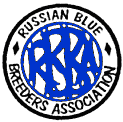 |
 |
 |
 |
 |
 |
 |
 |
 |
 |
|
|
Eye Colour in White Cats There are no specific genes for eye colour but it would appear that eye colour is closely linked to the colour and pattern of the coat. Pigment cells are responsible for giving cats their coloured eyes as well as coloured skin and fur. Eyes with limited pigment are blue and there would appear to be a link between blue eyes and deafness. Most breeders are aware that if a white kitten has a “kitten cap” it is unlikely to be deaf however that is not guaranteed. The cap can indicate how far the pigment cells responsible for colour have travelled from what is known as the neural crest but little else. It must be stressed that the majority of odd eyed or blue eyed cats are not deaf. At one time it was thought that all odd/blue eyed cats were homozygous with coloured eyed cats being heterozygous but this is not the case. Yet it would appear that homozygous white cats produce odd/blue eyes more frequently than heterozygous white cats. However a kitten with only one white parent can still have odd/blue eyes and/or be deaf. It must be noted here, that the Himalayan gene that is responsible for cats with coloured points and blue eyes nor the white spotting gene (both recessive genes that can be carried) are not related to the gene that is responsible for Russian Whites. The gene in play here is a dominant gene and as such it cannot be carried. Therefore any Russian that has the white gene present will always be white in appearance. Research has shown that odd/blue eyes and/or deafness can run in lines therefore the more odd/blue eyed and/or deaf cats in a pedigree the greater the chance of producing odd/blue eyed and/or deaf cats. By only using cats that have the required green eyes for breeding will not prevent the appearance of odd/blue eyed kittens but should lessen the likelihood of kittens with these eye colours being born. Russian Blues and Blacks will not produce odd or blue eyes as they do not carry the white gene to which they are linked. Unfortunately there is much about eye colour that is yet to be understood. For example – why is it that the British white has primarily orange eyes and yet the Russian white has primarily green eyes in spite of the fact that the two breeds have identical coat colour genotypes? How do you identify a kitten with odd or blue eyes? All kittens are born with blue eyes and the colour develops as they mature. To complicate matters further, different lines can develop their eye colour at slower rates than others. The presence of a kitten cap is no guarantee so you need to play the waiting game! If they are odd eyed you will notice that the iris starts to change colour in one eye while the other generally appears to become a paler shade of blue. Depending on the line you are working with this may be seen as early as six weeks but is more likely to be seen as the kitten reaches eight to nine weeks old. With blue eyed cats there is no change in the birth colour although it may go a paler shade.
If you take a photo especially with a flash, the retina of the blue eye will reflect a pink or red colour.
Don’t rush to register your kittens – be sure they are all green eyed before you do so but if one is not.......... At present, odd/blue eyed cats cannot be registered however they can be declared. We are requesting the RBAC applies to the GCCF for the granting of the appropriate breed numbers for these cats so that they can be registered correctly. We know that the GCCF systems are set up to allow this. At present we are the only breed producing white self’s that do not allow the registration of odd/blue eyed cats. These kittens are as “pedigree” as their green eyed siblings and they need to be recognised as such. We also need to be aware of their existence and ensure they are not used for breeding as this could heighten the chances of producing kittens with these eye colours which are undesirable in Russian Whites. For the moment - if you declare them when you register their siblings and inform Melva Eccles, the breed recorder, of this it will help us to build a clearer picture of the prevalence of these eye colours in the Russian Whites. You will also be able to register them in retrospect when we get the approval of the GCCF. On a purely mercenary thought – it means that you will be able to sell the kittens in exactly the same way as the rest of their “pet quality” siblings! Kitten cap: Homozygous: Heterozygous: Neural crest: With many thanks to Elizabeth Stark for helping me to simplify some of the scientific words and explanations contained within this article. If you wish to know more about the inheritance of eye colour and the science behind it please read Elizabeth’s excellent article which is available by request from raccs@hotmail.co.uk. Mrs CM Kaye |
